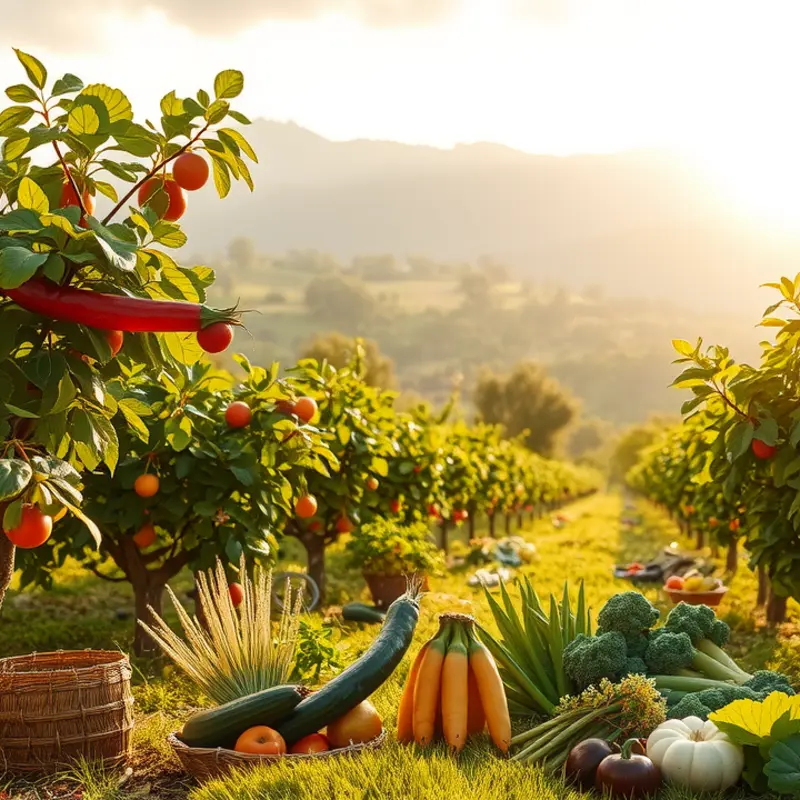Choosing sustainable cooking ingredients is a vital step toward healing our planet while enjoying delicious meals. By focusing on environmentally-friendly options, eco-conscious individuals can support sustainable farming practices, reduce carbon footprints, and enhance biodiversity. This guide provides actionable insights into sustainable ingredients that promote a healthier lifestyle and a thriving ecosystem. Whether you’re an experienced chef or a beginner in the kitchen, making conscious choices about your food can significantly impact the environment.
Fruits and Vegetables: The Cornerstone of Sustainability

Exploring local and seasonal produce offers a viable pathway to sustainability. By choosing fruits and vegetables that are grown nearby and in season, we reduce the need for long-distance transportation, which significantly cuts down on carbon emissions. This choice not only shortens supply chains but also ensures a fresher product, often with superior taste and nutritional content.
Sourcing organically is another way to embrace sustainable practices. Organic farming eliminates the use of synthetic fertilizers and pesticides, reducing soil and water contamination. Organic farms also tend to promote biodiversity and improve soil health, contributing positively to our ecosystems. As such, when you opt for organic produce, you are not just selecting chemical-free foods; you are supporting farming practices that nurture the earth.
The benefits of choosing locally grown produce extend beyond environmental rewards. By purchasing from local farmers, consumers inject money back into their communities, sustaining local businesses and economies. Farmers’ markets and community-supported agriculture (CSA) schemes are excellent avenues for finding fresh, local produce. These platforms often provide direct interactions with the farmers, fostering a deeper understanding of where our food comes from and how it is grown.
To further support sustainability, consider reducing food waste by planning your meals around available seasonal produce. A practical approach is ingredient batching, which allows you to use similar ingredients across multiple dishes, minimizing leftovers and ensuring nothing goes to waste. For more insights on how to reduce waste in your cooking preparations, you can explore low-waste cooking strategies, which provide effective methods to maximize your ingredient use.
When selecting produce, aim to choose imperfect fruits and vegetables. These “imperfect” options, often discarded due to aesthetic standards, are just as nutritious. By selecting them, you prevent unnecessary waste and support farmers in utilizing their entire harvest. Hence, embracing these choices not only supports farmers but also reduces food loss.
As consumers, using our purchasing power wisely can lead to significant environmental benefits. By paying attention to how and where our fruits and vegetables are grown, we shape an eco-friendlier agricultural model and champion a healthier planet. With these actions, the collective impact of our choices can sustain our natural resources for generations to come, paving the way for a sustainable future.
Plant-Based Proteins: Nourishing Both You and the Planet

Plant-based proteins offer a powerful alternative to animal-based proteins, both nutritionally and environmentally. By focusing on options such as legumes, nuts, and seeds, individuals can support their health while contributing to a more sustainable food system.
Legumes, including beans, lentils, and chickpeas, are a cornerstone of plant-based nutrition. They are rich in protein, fiber, and essential nutrients like iron and folate. Their versatility makes them ideal for a variety of dishes, from stews to salads. Compared to animal agriculture, legumes have a lower carbon footprint, conserve water, and improve soil health through nitrogen fixation.
Nuts and seeds are another excellent source of plant-based proteins. Almonds, walnuts, chia seeds, and flaxseeds, for example, provide essential fatty acids, proteins, and antioxidants. Including these in diets not only enhances nutrient diversity but also supports energy intake without the environmental cost of large-scale livestock farming.
To maximize the benefits of plant-based proteins, it’s crucial to choose sustainably sourced ingredients. Opting for organic or local producers can minimize environmental impact. Additionally, purchasing in bulk reduces packaging waste, further contributing to eco-friendly practices. Cooking with whole, unprocessed forms of these proteins can also be more sustainable and nutritious than processed alternatives.
Minimizing waste in the kitchen is another vital component of sustainable eating. Incorporate tips from low-waste cooking strategies, such as using every part of your vegetables and composting scraps. Learn more about minimizing waste when cooking.
Balancing nutritional needs requires a varied diet. It is useful to explore combinations of plant-based proteins to ensure complete amino acid profiles. For example, pairing legumes with grains, like rice or quinoa, can enhance the overall nutritional quality of meals.
Incorporating plant-based proteins into culinary practices can be both an exciting and meaningful contribution to environmental sustainability. Each small change, whether it’s choosing a lentil soup over a meat stew, or a handful of almonds instead of processed snacks, contributes to a healthier planet.
Final words
Adopting sustainable cooking ingredients not only contributes to personal health but also fosters environmental stewardship. By choosing local, seasonal produce and plant-based proteins, you support practices that minimize harm to the planet and enhance biodiversity. Each meal offers an opportunity to make choices that align with your values and contribute to a more sustainable future. Embrace this journey with an open mind and an adventurous palate, knowing that your decisions today can promote a healthier planet for future generations. Remember, it’s not just about what you cook but how those choices can effectuate change.








